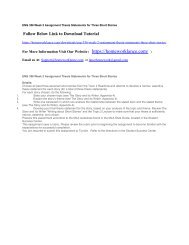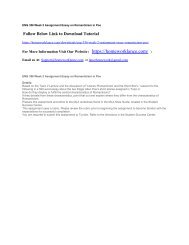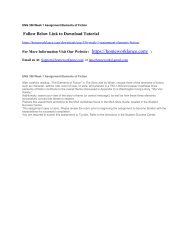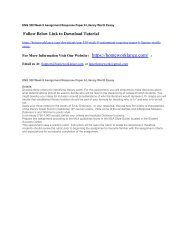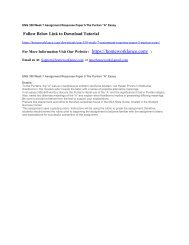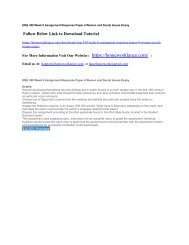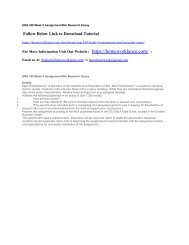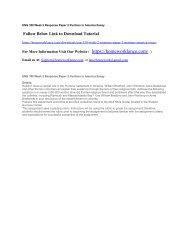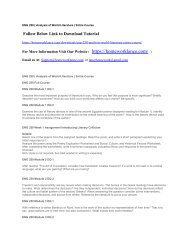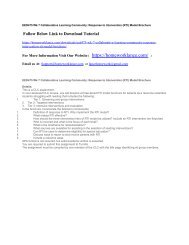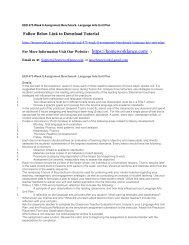ENG 356 Full Course – All Weeks Discussion and Assignments
You also want an ePaper? Increase the reach of your titles
YUMPU automatically turns print PDFs into web optimized ePapers that Google loves.
<strong>ENG</strong> <strong>356</strong> <strong>Full</strong> <strong>Course</strong> <strong>–</strong> <strong>All</strong> <strong>Weeks</strong> <strong>Discussion</strong> <strong>and</strong> <strong>Assignments</strong><br />
Follow Below Link to Download Tutorial<br />
https://homeworklance.com/downloads/eng-<strong>356</strong>-full-course-weeks-discussion-assignments/<br />
For More Information Visit Our Website ( https://homeworklance.com/ )<br />
Email us At: Support@homeworklance.com or lancehomework@gmail.com<br />
<strong>ENG</strong> <strong>356</strong> <strong>Full</strong> <strong>Course</strong> <strong>–</strong> <strong>All</strong> <strong>Weeks</strong> <strong>Discussion</strong> <strong>and</strong> <strong>Assignments</strong><br />
<strong>ENG</strong> <strong>356</strong> <strong>Full</strong> <strong>Course</strong><br />
<strong>ENG</strong> <strong>356</strong> Week 1 Topic 1 DQ 1<br />
We read about critical reading in Reading <strong>and</strong> Writing about Literature. How does one apply critical reading to short<br />
fiction <strong>and</strong> to short nonfiction pieces? Discuss two differences in approach <strong>and</strong> application of critical reading skills.<br />
<strong>ENG</strong> <strong>356</strong> Week 1 Topic 1 DQ 2<br />
Apply the seven elements of fiction as outlined in chapter 5 of Reading <strong>and</strong> Writing About Literature to Edgar <strong>All</strong>en<br />
Poe’s review, “The Importance of the Single Effect in a Prose Tale.” Determine whether or not Poe addressed all<br />
seven elements or if not, what do you see as lacking in his review?<br />
<strong>ENG</strong> <strong>356</strong> Week 1 Assignment Elements of Fiction<br />
After carefully reading, “The Elements of Fiction” in The Story <strong>and</strong> Its Writer, choose three of the elements of fiction,<br />
such as character, setting, plot, point of view, or style, <strong>and</strong> analyze in a 750-1,000-word essay howthese three<br />
elements of fiction contribute to the overall theme (discussed in Appendix 2) in Washington Irving’s story, “Rip Van<br />
Winkle.”<br />
Additionally, assert your view of the story’s theme (or central message), as well as how these three elements<br />
successfully convey that theme to readers.<br />
Prepare this assignment according to the MLA guidelines found in the MLA Style Guide, located in the Student<br />
Success Center.<br />
This assignment uses a rubric. Please review the rubric prior to beginning the assignment to become familiar with the<br />
expectations for successful completion.<br />
You are required to submit this assignment to Turnitin. Refer to the directions in the Student Success Center.<br />
<strong>ENG</strong> <strong>356</strong> Week 2 Topic 2 DQ 1<br />
Analyze Poe’s use of suspense in “The Cask of Amontillado” <strong>and</strong> “Ligeia.” What narrative devices does Poe use, in<br />
both stories, to heighten the suspense? What do these stories suggest about the human spirit <strong>and</strong> condition?<br />
<strong>ENG</strong> <strong>356</strong> Week 2 Topic 2 DQ 2<br />
An allegory is a narrative that has an extended dual meaning. One meaning resides in the literal action <strong>and</strong> plot of the<br />
story <strong>and</strong> another meaning, just as significant, resides in the ideas, values, or messages these actions are intended<br />
to convey. Nathaniel Hawthorne’s “Young Goodman Brown” is interesting both on its surface level of action <strong>and</strong> plot<br />
on its deeper, more symbolic level. Notice how the central characters of “Goodman” (a generic Puritan term meaning<br />
“gentleman”) <strong>and</strong> “Faith” represent abstract qualities. How does this story, with its emphasis on the dark undercurrent<br />
of evil in this seemingly tranquil New Engl<strong>and</strong> town, function as a moral allegory?<br />
<strong>ENG</strong> <strong>356</strong> Week 2 Assignment Essay on Romanticism in Poe<br />
Details:<br />
Based on the Topic 2 Lecture <strong>and</strong> the discussion of “Literary Romanticism <strong>and</strong> the Short Story,” respond to the<br />
following in a 500-word essay about the two Edgar <strong>All</strong>en Poe’s short stories assigned in Topic 2:<br />
How do they display or fulfill the central characteristics of Romanticism?
If they deviate from these characteristics, point that out <strong>and</strong> explain where they differ from the characteristics of<br />
Romanticism.<br />
Prepare this assignment according to the MLA guidelines found in the MLA Style Guide, located in the Student<br />
Success Center.<br />
This assignment uses a rubric. Please review the rubric prior to beginning the assignment to become familiar with the<br />
expectations for successful completion.<br />
You are required to submit this assignment to Turnitin. Refer to the directions in the Student Success Center.<br />
<strong>ENG</strong> <strong>356</strong> Week 2 Assignment Thesis Statements for Three Short Stories<br />
Details:<br />
Choose at least three assigned short stories from the Topic 2 Readings <strong>and</strong> attempt to develop a narrow, assertive<br />
thesis statement for each story (for a total of three thesis statements).<br />
For each story chosen, do the following:<br />
1. State your chosen topic (see The Story <strong>and</strong> Its Writer, Appendix 4).<br />
2. Explain the story’s theme (see The Story <strong>and</strong> Its Writer, Appendix 4).<br />
3. Write one paragraph in which you analyze the relationship between the stated topic <strong>and</strong> the stated theme<br />
(see The Story <strong>and</strong> Its Writer, Appendix 4).<br />
4. Develop your final thesis statement for the story, based on your analysis of the topic <strong>and</strong> theme. Review The<br />
Story <strong>and</strong> Its Writer “Writing about Short Stories” <strong>and</strong> the Topic 2 Lecture to make sure that your thesis is sufficiently<br />
narrow, assertive, <strong>and</strong> unique.<br />
Prepare this assignment according to the MLA guidelines found in the MLA Style Guide, located in the Student<br />
Success Center.<br />
This assignment uses a rubric. Please review the rubric prior to beginning the assignment to become familiar with the<br />
expectations for successful completion.<br />
You are required to submit this assignment to Turnitin. Refer to the directions in the Student Success Center.<br />
<strong>ENG</strong> <strong>356</strong> Week 3 Topic 3 DQ 1<br />
Discuss the relationship between the central character (protagonist) <strong>and</strong> the natural world in Stephen Crane’s “The<br />
Open Boat.” What does this character learn about himself <strong>and</strong> about his environment through his encounters with the<br />
natural world? Based upon this famous example of literary naturalism, how would you define the naturalistic view of<br />
humanity’s relationship with the physical world?<br />
<strong>ENG</strong> <strong>356</strong> Week 3 Topic 3 DQ 2<br />
Write a short critique about Charlotte Perkins Gilman’s “The Yellow Wallpaper.” Address the assumptions: “literary<br />
texts mirror gender <strong>and</strong> societal attitudes about gender” <strong>and</strong> “oppression of women as a historical fact.”<br />
<strong>ENG</strong> <strong>356</strong> Week 3 Applying Literary Criticism to a Short Story<br />
Details:<br />
After carefully reading the topic 3 Lecture <strong>and</strong> Appendix 5 in the The Story <strong>and</strong> Its Writer, choose one form of literary<br />
criticism (formalist, psychological, reader-response, etc.) <strong>and</strong> apply it to one of the short stories assigned during Topic<br />
3.<br />
In a 750-1,000-word essay, discuss how your chosen type of criticism would enlarge a reader’s underst<strong>and</strong>ing of the<br />
story <strong>and</strong> explain how at least three specific passages of the story could be interpreted using this form of criticism.<br />
Prepare this assignment according to the MLA guidelines found in the MLA Style Guide, located in the Student<br />
Success Center.<br />
This assignment uses a rubric. Please review the rubric prior to beginning the assignment to become familiar with the<br />
expectations for successful completion.<br />
You are required to submit this assignment to Turnitin. Refer to the directions in the Student Success Center<br />
<strong>ENG</strong> <strong>356</strong> Week 4 Topic 4 DQ 1<br />
In literary criticism, the word “epiphany” refers to a moment in which a character experiences a sudden, life-changing<br />
revelation about the true nature of something (often this can be an aspect of his or her character). These moments of<br />
insight are usually prompted by something seemingly trivial or commonplace, but they result in a radical change of
perception on the part of the character. Consider either James Joyce’s “Araby” or “The Dead” <strong>and</strong> explain how the<br />
central character in either of these stories experiences an epiphanic moment. What does the protagonist learn about<br />
himself, about another person, or about life, <strong>and</strong> how does this experience <strong>and</strong> gained insight change him?<br />
<strong>ENG</strong> <strong>356</strong> Week 4 Topic 4 DQ 2<br />
In Katherine Mansfield’s short story “Bliss,” does the character Bertha truly have “everything” as she insists? Explain<br />
<strong>and</strong> then share at least three significant details in the story that reveal aspects of Bertha’s character <strong>and</strong> life to you<br />
<strong>ENG</strong> <strong>356</strong> Week 4 Assignment Symbolism in Hemingway<br />
Details:<br />
Literary Modernism is often associated with a highly symbolic portrayal of human experience, including people’s<br />
thoughts <strong>and</strong> emotions, through the use of concrete, visual images. Analyze the symbolism contained in<br />
Hemingway’s “Hills Like White Elephants” in order to uncover the story’s possible thematic meaning(s). For instance,<br />
consider carefully images such as the setting between two rail lines; the dry, barren hills; the green fields of grain <strong>and</strong><br />
trees; the suggestion of “white elephants” (something both precious <strong>and</strong> useless in some Eastern cultures); the<br />
images of alcohol, etc.<br />
How do these visual symbols <strong>and</strong> images help a reader underst<strong>and</strong> the man, the woman, <strong>and</strong> the nature of their<br />
conflict? Write a response to the question in a 500-750-word essay.<br />
Prepare this assignment according to the MLA guidelines found in the MLA Style Guide, located in the Student<br />
Success Center.<br />
This assignment uses a rubric. Please review the rubric prior to beginning the assignment to become familiar with the<br />
expectations for successful completion.<br />
You are required to submit this assignment to Turnitin. Refer to the directions in the Student Success Center.<br />
<strong>ENG</strong> <strong>356</strong> Week 5 Topic 5 DQ 1<br />
Apply the elements of regional fiction (dialect; authentic speech patterns; regional diction; specific, concrete imagery;<br />
<strong>and</strong> specific, regional settings) to the Richard Wright story, “The Man Who Was Almost a Man.” Provide one example<br />
of each of the elements.<br />
<strong>ENG</strong> <strong>356</strong> Week 5 Topic 5 DQ 2<br />
Thinking about the categories of local color <strong>and</strong> regional fiction, how would you say that Zora Neale Hurston’s<br />
“Spunk” reflects the qualities found in the two categories? Give three specific examples from the story.<br />
<strong>ENG</strong> <strong>356</strong> Week 5 Assignment Regional Southern Fiction Analysis<br />
Details:<br />
How can the two stories by Flannery O’Connor be seen as examples of “local color” or “regional” Southern fiction? To<br />
what extent are the stories dependent on their specific Southern settings? To what extent do the stories’ characters<br />
<strong>and</strong> themes transcend these settings? Pay close attention to elements of regional fiction such as dialect, authentic<br />
speech patterns, regional diction, specific, concrete imagery, <strong>and</strong> specific, regional settings. Respond in an essay of<br />
750-1,000 words.<br />
Prepare this assignment according to the MLA guidelines found in the MLA Style Guide, located in the Student<br />
Success Center.<br />
This assignment uses a rubric. Please reveiw the rubric prior to beginning the assignment to become familiar with the<br />
expectations for successful completion.<br />
You are required to submit this assignment to Turnitin. Refer to the directions in the Student Success Center.<br />
<strong>ENG</strong> <strong>356</strong> Week 6 Topic 6 DQ 1<br />
In Grace Paley’s “A Conversation with my Father,” both the narrator <strong>and</strong> her father have specific conceptions of truth.<br />
Describe both characters’ conceptions of truth <strong>and</strong> discuss what comment the story seems to make about these<br />
versions of truth. Does the story itself seem to privilege one conception over the other? Explain.<br />
<strong>ENG</strong> <strong>356</strong> Week 6 Topic 6 DQ 2
In Raymond Carver’s essay, “On Writing,” (in “The Story <strong>and</strong> its<br />
Writer”) he states: “too often ‘experimentation’ [in writing] is a<br />
license… to try to brutalize or alienate the reader. Too often such writing gives us no news of the world, or else<br />
describes a desert l<strong>and</strong>scape <strong>and</strong> that’s all ― a few dunes <strong>and</strong> lizards here <strong>and</strong> there, but no people; a place<br />
uninhabited by anything recognizably human, a place of interest only to a few scientific specialists.” What extent does<br />
this critique of some forms of Postmodern fiction, those in which the authors are apparently more concerned with<br />
linguistic innovation than with conveying anything seemingly real or significant to a reader, apply to the fiction<br />
assigned in the Topic 6 Readings? Choose two of the assigned readings <strong>and</strong> explain why this critique does or does<br />
not apply to these works.<br />
<strong>ENG</strong> <strong>356</strong> Week 6 Assignment Analysis Paper Outline<br />
Details:<br />
In a formal or informal sketch outline, list the major assertions <strong>and</strong> subtopics of your paper that you will complete in<br />
Topic 8. Please check your options for this paper in the Topic 8 assignment. This outline should form the basic<br />
structure for your research paper, but you may find that you change or modify the paper or outline in your actual<br />
writing <strong>and</strong> revision.<br />
The outline should, minimally, contain the following elements:<br />
1. A creative, unique title for your paper.<br />
2. A statement of your thesis at the top.<br />
3. Parallel topics <strong>and</strong> subtopics.<br />
4. Complete sentences, unless phrases are clear.<br />
5. At least two sub-categories for each paragraph topic listed.<br />
6. A conventional system of numbers <strong>and</strong> letters (I.A.1.a., etc.).<br />
MLA format is not required, but solid academic writing is expected.<br />
<strong>ENG</strong> <strong>356</strong> Week 7 Topic 7 DQ 1<br />
In Tan’s “Two Kinds,” how typical is Tan’s depiction of the mother-daughter, or generational, conflict? Is the story<br />
meant to be primarily about the Asian-American experience or is it meant to be more universal?<br />
<strong>ENG</strong> <strong>356</strong> Week 7 Topic 7 DQ 2<br />
Compare <strong>and</strong> contrast the mother-daughter relationship in Tillie Olsen’s “I St<strong>and</strong> Here Ironing” <strong>and</strong> Amy Tan’s “Two<br />
Kinds.” The mother narrates Olsen’s story, while the daughter narrates Tan’s. How are these two relationships similar<br />
<strong>and</strong> different? How does the depiction of these relationships contribute to the stories’ themes?<br />
<strong>ENG</strong> <strong>356</strong> Week 7 Assignment African American Cultural Influence on an Author<br />
Details:<br />
In “Everyday Use,” Alice Walker analyzes the complexities associated with race, class, gender, <strong>and</strong> society. Similar to<br />
James Baldwin, Walker uses her unique, narrative style to explore the “ambiguity <strong>and</strong> irony found in Negro life,”<br />
especially in regards to sibling relationships <strong>and</strong> the outside forces that attempt to destroy the bond.<br />
Compare <strong>and</strong> contrast how Baldwin’s <strong>and</strong> Walker’s characters use this connection as the means to sort through their<br />
‘inner blues.’ Respond in an essay of 750-1,000 words.<br />
Prepare this assignment according to the MLA guidelines found in the MLA Style Guide, located in the Student<br />
Success Center.<br />
This assignment uses a grading rubric. Please review the rubric prior to beginning the assignment to become familiar<br />
with the expectations for successful completion.<br />
You are required to submit this assignment to Turnitin. Refer to the directions in the Student Success Center.<br />
<strong>ENG</strong> <strong>356</strong> Week 8 Topic 8 DQ 1<br />
Max Points: 5.0<br />
In “Madman,” what evidence supports Chinua Achebe’s view that there are different forms <strong>and</strong> degrees of<br />
“madness?”<br />
<strong>ENG</strong> <strong>356</strong> Week 8 Topic 8 DQ 2
Gabriel Garcia Marquez’s story, “A Very Old Man with Enormous Wings,” blends magical realism with a simple,<br />
straightforward style of writing. In the story, Marquez incorporates satire, irony, <strong>and</strong> humor, while also addressing<br />
serious <strong>and</strong> somewhat dark themes <strong>and</strong> topics. Choose two or three key elements of Marquez’s style (humor,<br />
magical realism, irony, satire, metaphor, etc.). How do these literary techniques help him to convey the story’s<br />
possible central theme or message?<br />
<strong>ENG</strong> <strong>356</strong> Week 8 Assignment Analysis Paper<br />
Details:<br />
Using the outline you developed, produce a final draft of the Analysis Paper.<br />
In a carefully constructed paper of 1,800-2,000 words (six to seven pages), respond to one of the following topics.<br />
Make sure that the essay has a focused, narrow, assertive thesis, <strong>and</strong> that it contains abundant textual support for all<br />
subassertions <strong>and</strong> claims (direct quotations, paraphrases, or summaries). You can write on a particular writer or story<br />
only once in the semester.<br />
Topic One: Analysis of Style in Relation to Theme <strong>–</strong> Choose one or two assigned short stories <strong>and</strong> analyze how<br />
specific elements of fiction, such as symbolism, imagery, setting, characterization, plot structure, or language<br />
contribute to the story’s central theme (e.g., imagery of light, vision, <strong>and</strong> beauty in “Araby”). Make sure you explain<br />
how <strong>and</strong> why, <strong>and</strong> make your thesis very specific <strong>and</strong> unique (do not merely present a statement of fact about the<br />
story or stories).<br />
Topic Two: Biographical Analysis of a Story or Stories <strong>–</strong> Choose two short stories by the same author <strong>and</strong><br />
explain how specific information about the author’s biography further elucidates or clarifies those short stories. Using<br />
credible, scholarly sources, research the author’s life, <strong>and</strong> focus on one specific aspect of that author’s life (religious<br />
background, education, specific experiences abroad or in specific schools, etc.) <strong>and</strong> on how that aspect of the<br />
author’s life provides further insight into how <strong>and</strong> why the author chose specific themes or literary techniques.<br />
Topic Three: Comparison <strong>and</strong> Contrast <strong>–</strong> Choose two or more assigned short stories <strong>and</strong> compare <strong>and</strong> contrast<br />
their unique presentations of particular topics such as war, death, marriage (e.g., compare <strong>and</strong> contrast the treatment<br />
of marriage in “The Story of<br />
an Hour” <strong>and</strong> “The Yellow Wallpaper.” A student essay about the topic is in chapter 5 of Reading <strong>and</strong> Writing about<br />
Literature). Compare emphasizes the similarities between two or more items. Contrast underscores differences.<br />
Topic Four: The Application of a Literary Critical Model to a Short Story <strong>–</strong> Apply a specific method of literary<br />
criticism to one or two short stories in an attempt to further<br />
elucidate or enlarge a reader’s underst<strong>and</strong>ing of the story or stories (e.g., “The Story of an Hour,” “I St<strong>and</strong> Here<br />
Ironing,” “The Yellow Wallpaper,” etc.).<br />
Review Appendix 4 in the The Story <strong>and</strong> Its Writer, “Writing About Short Stories,” <strong>and</strong> the Topic 2 Lecture for<br />
information on writing critical analyses of short stories. This paper should be an analysis, not merely an explication, of<br />
the text(s).<br />
Prepare this assignment according to the MLA guidelines found in the MLA Style Guide, located in the Student<br />
Success Center.<br />
This assignment uses four grading rubrics which are attached below. Please view the appropriate rubric for your<br />
selected topic prior to beginning the assignment to become familiar with the expectations for successful completion.<br />
You are required to submit this assignment to Turnitin. Refer to the directions in the Student Success Center.



